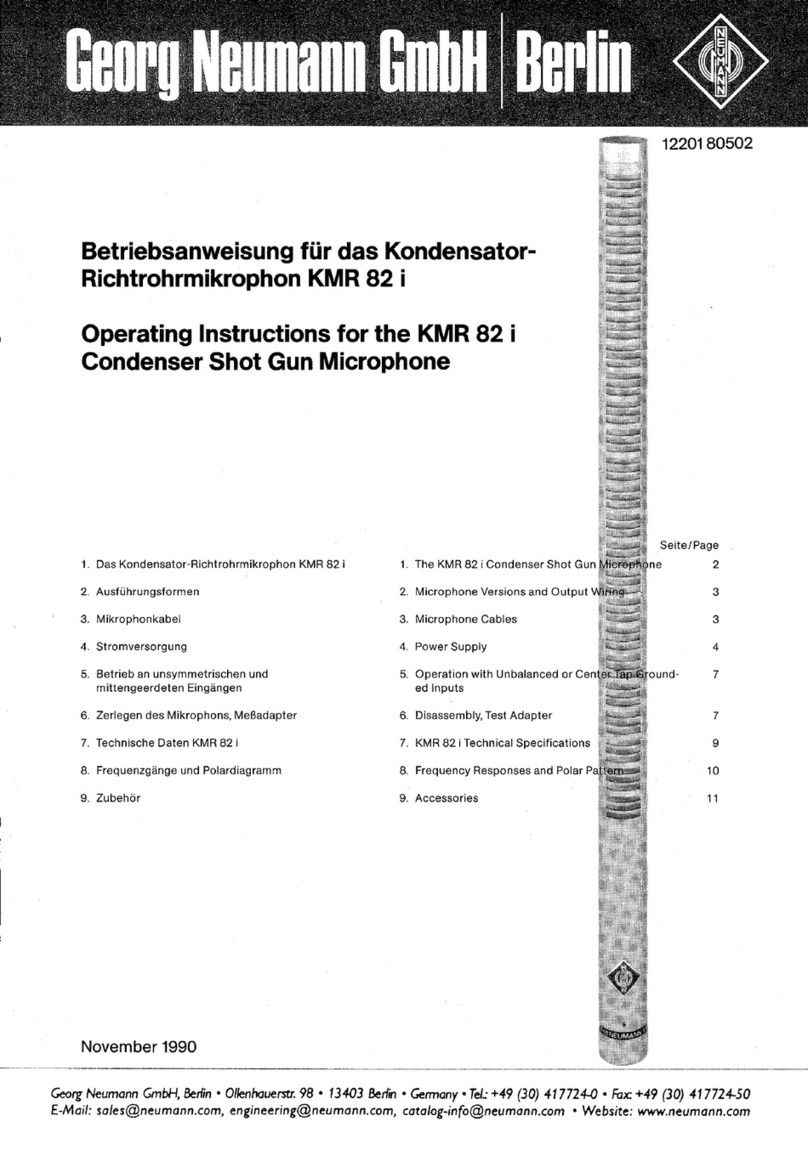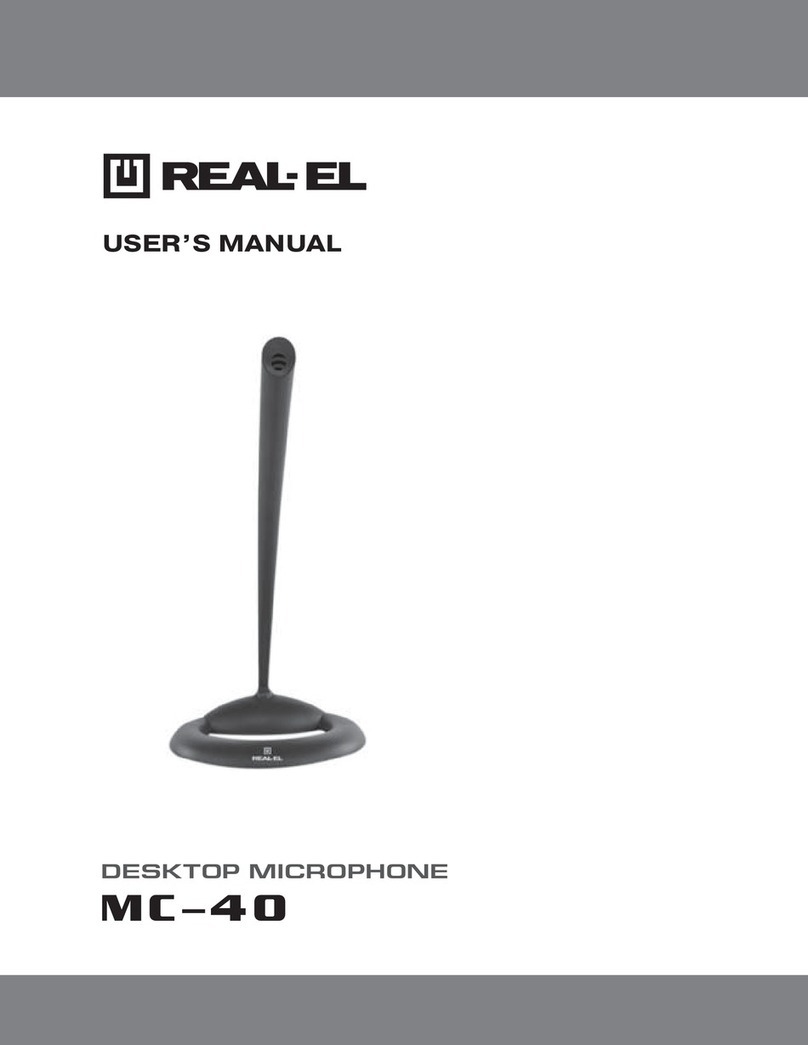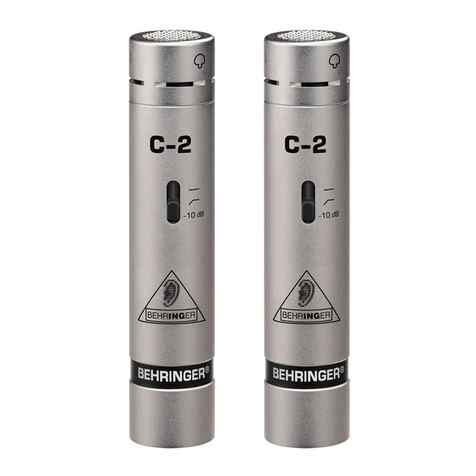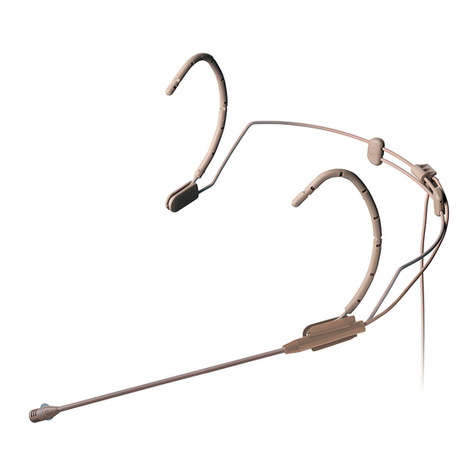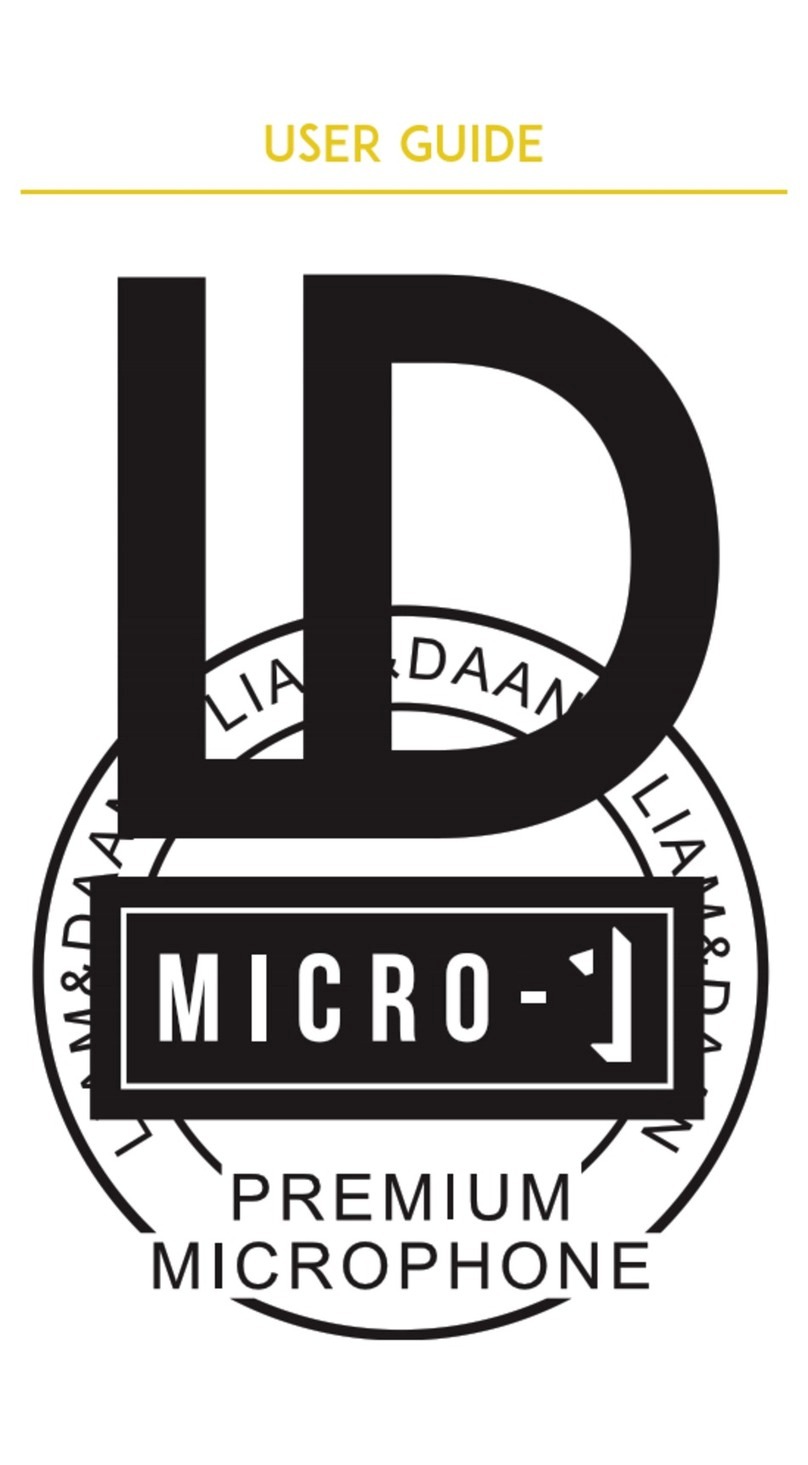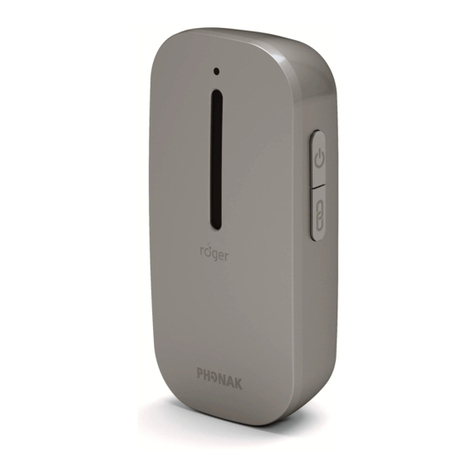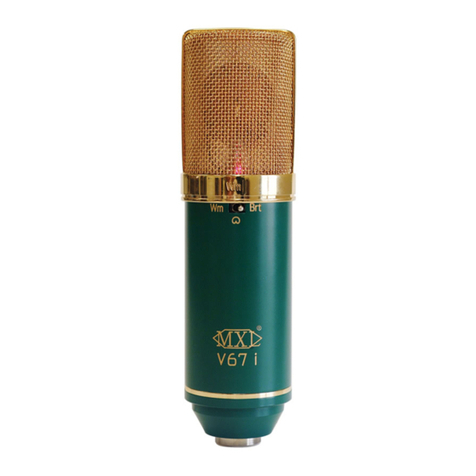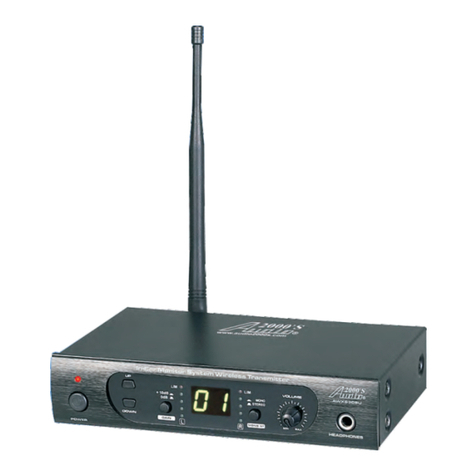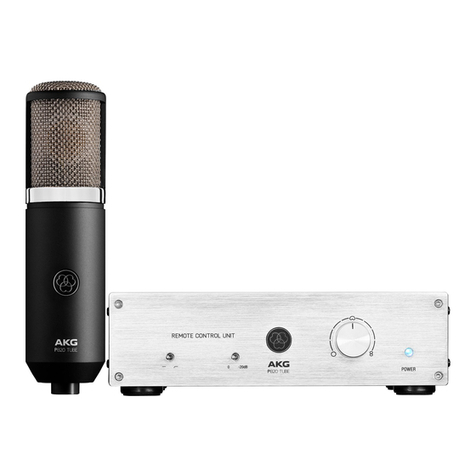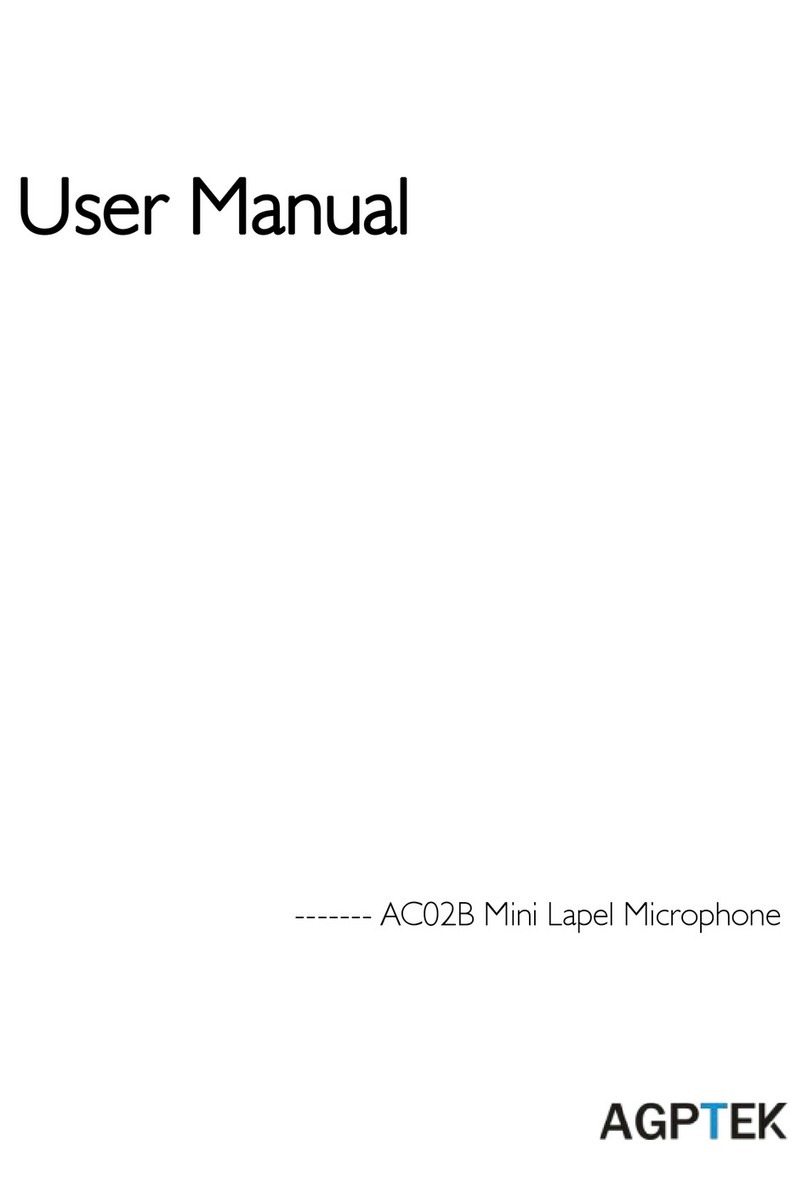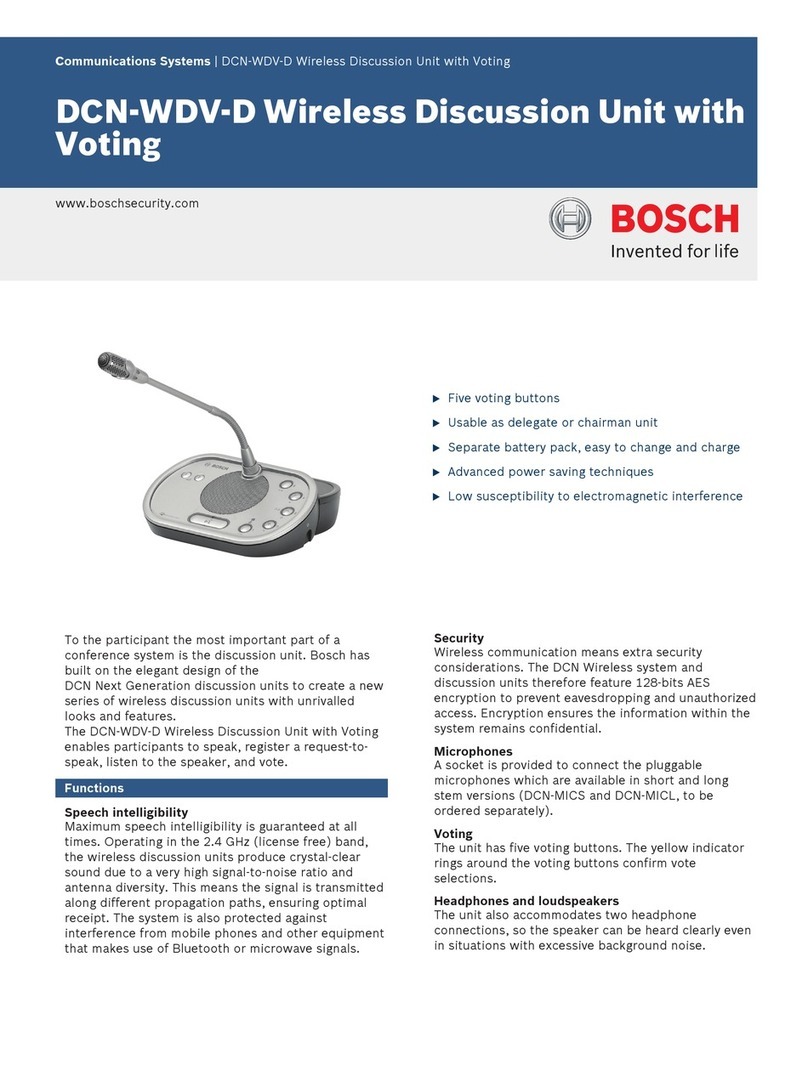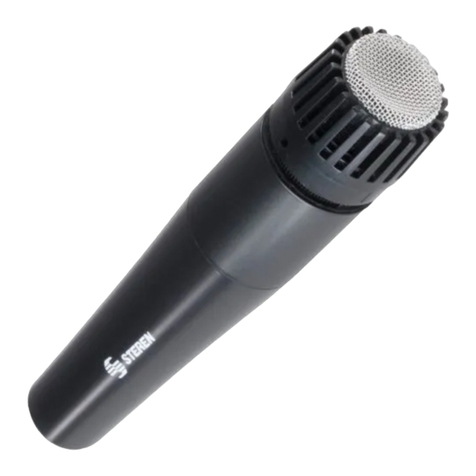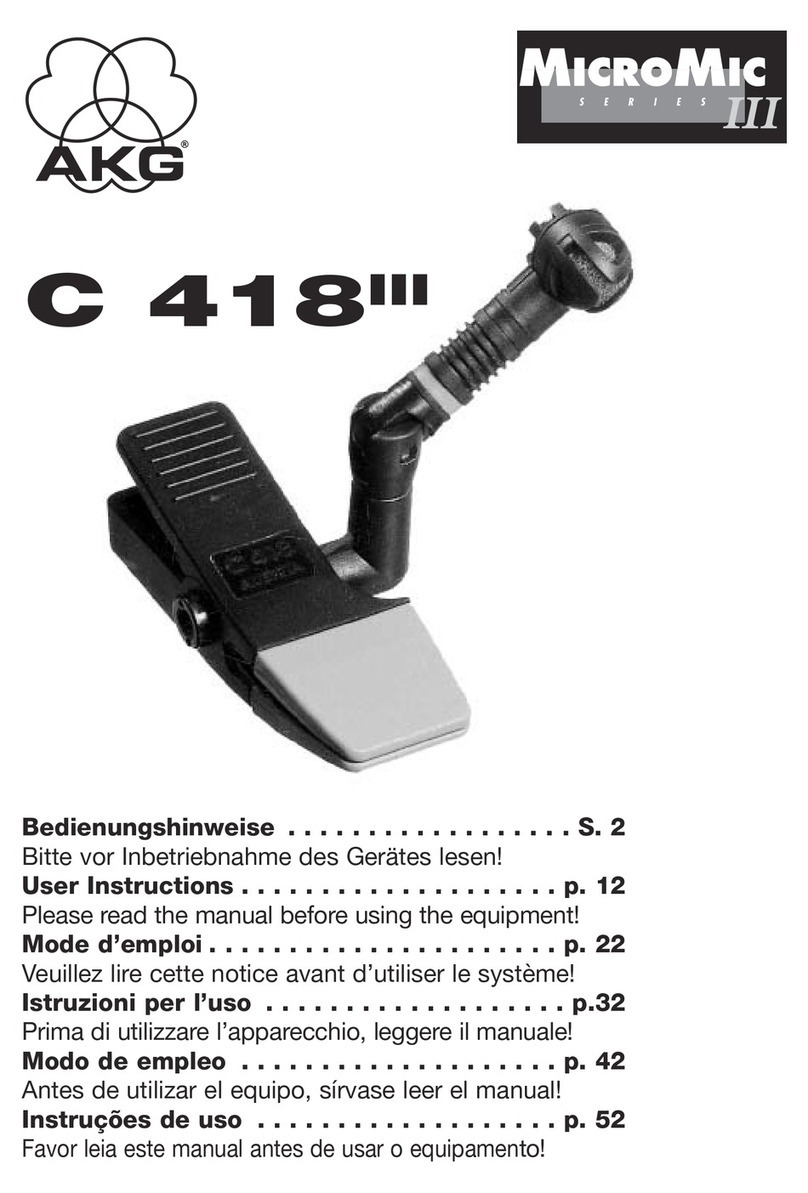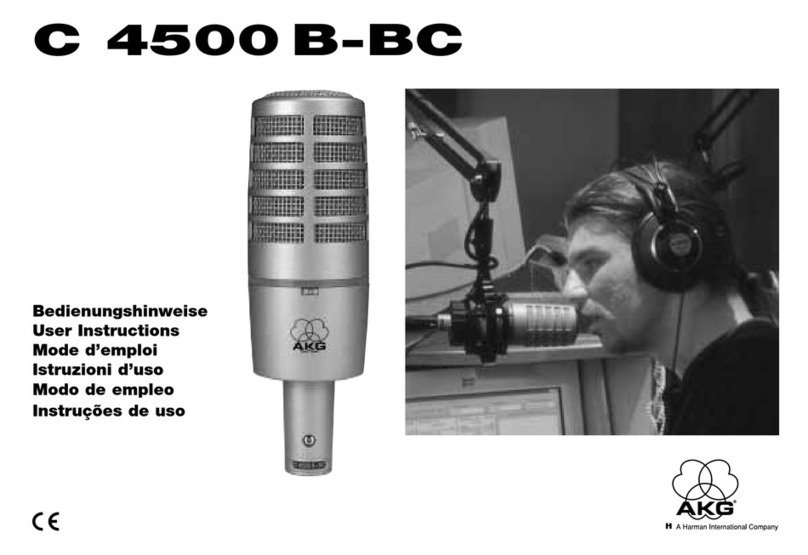Georg Neymann TLM 193 User manual

Bedienungsanleitung
Operating Instructions
TLM 193
Ollenhauerstr. 98
13403 Berlin
Germany
Tel.: +49-30 / 417724-0
Fax: +49-30 / 417724-50
Email: [email protected]
Web: www.neumann.com

23
Inhaltsverzeichnis
1. Kurzbeschreibung
2. Das Kondensatormikrophon TLM 193
2.1 Ausführungsform und Beschaltung des
Mikrophonausganges
2.2 Mikrophonkabel
3. Stromversorgung
3.1 Phantomspeisung
3.2 Betrieb mit Netzgeräten
3.2.1 Konventioneller Betrieb
3.3 Batteriespeisung
3.4 Betrieb an unsymmetrischen oder
mittengeerdeten Eingängen
4. Technische Daten TLM 193
5. Frequenzgänge und Polardiagramme
6. Einige Hinweise zur Pflege von Mikrophonen
7. Zubehör
1. Kurzbeschreibung
Das Kondensatormikrophon TLM 193 ist ein Studio-
mikrophon mit der Richtcharakteristik Niere.
Es zeichnet sich aus durch
• besonders niedriges Eigengeräusch und höchste
Aussteuerbarkeit,
• transformatorlose Schaltungstechnik,
• besonders saubere, freie und verfärbungsfreie Klang-
übertragung.
Das Mikrophon hat einen symmetrischen, übertrager-
losen Ausgang.
Der 3-polige XLR-Stecker hat folgende Belegung:
Pin 1: 0 V/Masse
Pin 2: Modulation (+Phase)
Pin 3: Modulation (–Phase).
Feldübertragungsfaktor 18 mV/Pa = –35 dB re. 1 V/Pa.
Das Mikrophon wird mit 48 V, 3 mA phantomgespeist
(IEC 1938).
Table of Contents
1. Brief Description
2. The TLM 193
Condenser Microphone
2.1 Microphone Version and Output
Wiring
2.2 Microphone Cables
3. Power Supply
3.1 Phantom Powering
3.2 Operation with AC Power Supply
3.2.1 Conventional Operation
3.3 Battery Powering
3.4 Operation with Unbalanced or Center
Tap Grounded Inputs
4. TLM 193 Technical Specifications
5. Frequency Responses and Polar Pattern
6. Hints on Microphone Maintenance
7. Accessories
1. Brief Description
The TLM 193 is a studio condenser microphone with
cardioid polar pattern.
Its most important features are
• especially low self noise level combined with high-
est output capability,
• transformerless circuit,
• extraordinarily true sound transduction free of col-
oration.
The microphone has a balanced, transformerless out-
put.
The 3-pin XLR connector has the following pin as-
signments:
Pin 1: 0 V/ground
Pin 2: Modulation (+phase),
Pin 3: Modulation (–phase).
The free-field sensitivity is 18 mV/Pa = –35 dB re.
1 V/Pa. The microphone is phantom powered from
48 V, 3 mA (IEC 1938).
Die Einsprechrichtung ist seitlich, die Vorderseite wird
durch das Neumann-Logo gekennzeichnet.
Das Mikrophon wird in einem Holzetui zusammen mit
dem Stativgelenk SG 1 geliefert.
2. Das Kondensatormikrophon
TLM 193
Das Kondensatormikrophon TLM 193 ist ein Studio-
mikrophon der Serie fet 100 mit der Richtcharakteris-
tik Niere.
Die Buchstaben TLM stehen für „TT
TT
Transformatorllllloses
MM
MM
Mikrophon“.
Der zur Leistungsanpassung der Mikrophonausgangs-
spannung an die Betriebsspannung üblicherweise ver-
wendete Übertrager ist im TLM 193 durch eine elek-
tronische Schaltung ersetzt, die – wie ein Übertrager
– für eine gute Unsymmetriedämpfung sorgt. Daher
werden Störsignale, die auf die symmetrische Modu-
lationsleitung einwirken, wie gewohnt unterdrückt.
Die Eigenstörspannung des TLM 193 konnte gegen-
über vergleichbaren Mikrophontypen stark gesenkt wer-
den, wobei das Mikrophon Schalldruckpegel von 140 dB
unverzerrt überträgt und einen Dynamikumfang von
130 dB zur Verfügung stellt (nach DIN/IEC 651).
Das Kondensatormikrophon TLM 193 wird von der
Seite besprochen. Seine Vorderseite ist durch das
Neumann-Emblem gekennzeichnet.
Die im Drahtgeflechtkorb des Mikrophons befindliche
Doppelmembrankapsel besitzt einen besonders ebe-
nen Frequenzgang, und zwar nicht nur, wie vielfach
üblich, für den von vorn einfallenden Schall, sondern
auch für Schall, der seitlich innerhalb eines Winkelbe-
reichs von mehr als ±100° einfällt. Daher verlaufen auch
der Diffusfeld-Frequenzgang des TLM 193 bis 10 kHz
parallel zu der in Abschnitt 5 gezeigten 0°-Grad-Kurve.
Praktisch betrifft das die indirekt über Reflektionen im
Aufnahmeraum zum Mikrophon gelangenden Schallan-
teile. Damit wird auch ein etwa mitaufzunehmender
Nachhallschall durch das Mikrophon in seinem Klang-
charakter nicht verändert. Dies unterscheidet das
TLM 193 von einem Druckempfänger mit Kugelcha-
rakteristik, bei dem Diffus- und Freifeldfrequenzgang
nicht übereinstimmen können.
Da zum Erreichen der genannten Mikrophoneigenschaf-
ten keine Resonanzwirkungen genutzt werden, ist das
Impulsverhalten des Mikrophons ausgezeichnet, und
es vermag alle Ausgleichsvorgänge in Musik und Spra-
che unverfälscht zu übertragen.
The axis of maximum sensitivity is at right angles to
the main axis of the microphone. The front is desig-
nated by the Neumann logo.
The microphone comes in a wooden case including
the SG 1 swivel mount.
2. The TLM 193 Condenser
Microphone
The TLM 193 Condenser Microphone is a studio mi-
crophone of the fet 100 series with a cardioid polar
pattern.
The letters TLM stand for TT
TT
Transformerllllless MM
MM
Micro-
phone.
The transformer which used to couple a microphone’s
output to the supply voltage, has been replaced in
the TLM 193 by an electronic circuit which, like a
transformer, maintains the excellent common mode
rejection (CMR). Interference induced in the balanced
modulation line is therefore suppressed as usual.
The self-noise level of the TLM 193 is much lower
than that of comparable microphone models while its
overload capability extends to 140 dB SPL, providing
a dynamic range of 130 dB (DIN/IEC 651).
The TLM 193 has its axis of maximum sensitivity ar-
ranged radially; i.e. at right angles to the axis of its
body.
The microphone front is marked by the Neumann
insignia. Its grille houses a dual-membrane capsule
with a particularly linear frequency response. This lin-
earity applies not only for sound coming from the front
but also for sound incidence angles up to ±100°,
where the frequency response is flat up to 10 kHz. In
view of these facts it follows that the diffuse-field re-
sponse – namely the response in a lively acoustic en-
vironment with reflections entering the microphone
from all directions – will also be linear. This is of vital
importance in the recording environment and insures
that the tone color of reverberant sound will not be
altered by the microphone. This is in sharp contrast
to an omni-directional pressure transducer in which
the diffuse- and direct-field responses never match!
No resonance effects are used to obtain the charac-
teristics mentioned above. As a consequence, the mi-
crophone features excellent transient behaviour and
transmits all transient phenomena of music or voice
without distortion.

45
The entire exposed surface of the capsule, including
the membranes, is at ground potential making it im-
mune to electric as well as atmospheric conditions
and dirt. In order to protect the capsule from me-
chanical shock transmission it is elastically suspended.
As the TLM 193's amplifier is linear up to 20 Hz, ex-
tremely low frequency signals can be transmitted with-
out distortion as well. On the other hand the micro-
phone is therefore more sensitive to low-frequency
noises as structure-borne or wind and pop disturbanc-
es. For specific applications it is therefore recommend-
able to use protective accessories as the EA 1 (mt)
elastic suspension, the PS 15 or PS 20 a pop screens
or the WS 89 windscreen (see section 7).
2.1 Microphone Versions and
Output Wiring
The following versions of the TLM 193 microphone
are available:
TLM 193TLM 193
TLM 193TLM 193
TLM 193 ............................ blk .............................. Cat. No. 08381
Version with 3-pin XLR connector insert and matte
black finish. Requires XLR 3 F female connector.
Microphone wired as per IEC 60 268-12 or DIN EN
60 268-12:
Modulation is connected to pins 2 and 3; the shield
is connected to pin 1.
A sudden sound pressure rise in front of the front
diaphragm causes a positive voltage to appear at pin 2.
2.3 Microphone Cables
The following cables are available for the TLM 193
microphone:
IC 3 mtIC 3 mt
IC 3 mtIC 3 mt
IC 3 mt ................................. blk .............................. Cat. No. 06543
10 m microphone cable, 5 mm in diameter, with dou-
ble twist (double helix) braiding as shield. 3-pin XLR
connectors, matte black. For feeding the audio signal
to mixing consoles, etc.
ICIC
ICIC
IC 44
44
4 (10 m) ........................ ni ................................ Cat. No. 06547
ICIC
ICIC
IC 44
44
4 mt (10 m) ................ blk .............................. Cat. No. 06557
10 m microphone cable, 5 mm in diameter, with dou-
ble twist braiding as shield. 3-pin XLR connectors and
SGCD 3 (mt) rotatable swivel mount. It has a 5/8"-
27 female thread that can be fastened to tripods. A
threaded adapter for 1/2"- and 3/8" studs is included.
Designed for microphones with a threaded connec-
tion.
Die gesamte Oberfläche der Kapsel einschließlich der
Membranen liegt auf Massepotential und ist daher un-
empfindlich gegen elektrische und atmosphärische Ein-
flüsse und gegen Schmutz. Die Kapsel ist zum Schutz
gegen Körperschallübertragung elastisch gelagert.
Da der Verstärker des TLM 193 bis 20 Hz linear ver-
läuft, können auch extrem niederfrequente Signale
unverfälscht übertragen werden. Andererseits ist das
Mikrophon dadurch empfindlicher für tieffrequente Stö-
rungen wie Körperschall oder Pop- und Windgeräu-
sche. Daher empfiehlt sich eventuell die Verwendung
der Elastischen Aufhängung EA 1 (mt), des Popschirms
PS 15 oder PS 20 a oder des Windschutzes WS 89
(siehe Kapitel 7).
2.1 Ausführungsformen und Beschaltung des
Mikrophonausgangs
Das Mikrophon kann in folgenden Ausführungsformen
geliefert werden:
TLM 193TLM 193
TLM 193TLM 193
TLM 193 .............................. sw ............................. Best.-Nr. 08381
Ausführung mit 3-poligem XLR-Steckverbinder und
schwarzmatter Oberfläche. Erforderliches Gegenstück:
XLR 3 F.
Die Zuordnung der Mikrophonanschlüsse entspricht
DIN EN 60 268-12 bzw. IEC 60 268-12:
Die Modulationsadern liegen an Pin 2 und 3, die Ab-
schirmung an Pin 1.
Bei einem Schalldruckanstieg vor der vorderen Mikro-
phonmembran tritt an Pin 2 eine positive Spannung auf.
2.3 Mikrophonkabel
Für das TLM 193 stehen folgende Kabel zur Verfü-
gung:
IC 3 mtIC 3 mt
IC 3 mtIC 3 mt
IC 3 mt ................................. sw ............................. Best.-Nr. 06543
10 m langes Mikrophonkabel, Durchmesser 5 mm, mit
Doppeldrallumspinnung als Abschirmung. Schwarz-mat-
te 3-polige XLR-Steckverbinder. Führt am Ausgang des
Netzgerätes die Modulation weiter.
ICIC
ICIC
IC 44
44
4 (10 m) ........................ ni ............................... Best.-Nr. 06547
ICIC
ICIC
IC 44
44
4mtmt
mtmt
mt (10 m) ............... sw ............................. Best.-Nr. 06557
10 m langes Mikrophonkabel für Mikrophone mit Ge-
windeanschluss, Durchmesser 5 mm, mit Doppeldrall-
umspinnung als Abschirmung. Dreh- und schwenkba-
res Stativgelenk SGCD 3 (mt), 3-polige XLR-Steckver-
binder, der Gewindeanschluss hat 5/8"-27-Gang. Ein
Adapter für 1/2"- und 3/8"-Gewindezapfen wird mit-
geliefert.
ICIC
ICIC
IC 3131
3131
31 mt (5mt (5
mt (5mt (5
mt (5 m)m)
m)m)
m) ............... sw ............................. Best.-Nr. 06570
5 m langes Mikrophonkabel, Durchmesser 4,5 mm, mit
Doppeldrallumspinnung als Abschirmung. Schwarzmat-
te 3-polige XLR-Steckverbinder. Zur Vermeidung von
Reibgeräuschen bei der Verwendung an der Angel
oder an Kunststoffdurchführungen (z.B. bei Windschutz-
körben) ist das Kabel textilumsponnen.
ACAC
ACAC
AC 2222
2222
22 ........................................................................... Best.-Nr. 06598
0,3 m langes Adapterkabel mit einer 5-poligen XLR-
Buchse und einem 3,5 mm Stereoklinkenstecker, un-
symmetrisch, für den Anschluss des 5-poligen XLR-
Ausganges des Speisegerätes BS 48 i-2, der Matrixbox
MTX 191 A oder des N 48 R-2 an Geräte mit 3,5 mm
Stereoklinkenbuchse.
ACAC
ACAC
AC 2525
2525
25 ........................................................................... Best.-Nr. 06600
0,3 m langes Adapterkabel mit einer 3-poligen XLR-
Buchse und einem 6,3 mm Monoklinkenstecker, un-
symmetrisch, für den Anschluss des 3-poligen XLR-
Ausganges eines Speisegerätes BS 48 i oder N 48 i-2
an Geräte mit 6,3 mm Monoklinkenbuchse.
ACAC
ACAC
AC 2727
2727
27 ........................................................................... Best.-Nr. 06602
Y-Adapterkabel, 0,3 m lang, mit einer 5-poligen XLR-
Buchse und zwei 6,3 mm Monoklinkensteckern, un-
symmetrisch, für den Anschluss des 5-poligen XLR-
Ausganges eines Speisegerätes BS 48 i-2 oder der
Matrixbox MTX 191 A an Geräte mit 6,3 mm Mo-
noklinkenbuchsen.
Andere Kabellängen sind auf Wunsch lieferbar.
Das Mikrophon ist besonders unempfindlich gegen ka-
pazitive Belastung. TIM- und Frequenzgangverzerrun-
gen werden daher auch bei Verwendung sehr langer
Kabel nicht hervorgerufen.
Weitere Artikel sind im Katalog „Zubehör“ beschrieben.
3. Stromversorgung
3.1 Phantomspeisung
Das TLM 193 wird mit 48 V phantomgespeist (P48,
IEC 1938).
Bei der Phantomspeisung fließt der Speisestrom vom
positiven Pol der Spannungsquelle über die elektri-
sche Mitte der beiden Modulationsadern zum Mikro-
phon. Er wird hierzu über zwei gleiche Widerstände
in beiden Tonadern eingekoppelt. Die Rückleitung des
Gleichstroms erfolgt über den Kabelschirm. Zwischen
beiden Modulationsadern besteht also keine Potenti-
aldifferenz. Daher ist mit der Phantomspeisung eine
ICIC
ICIC
IC 3131
3131
31 mt (5mt (5
mt (5mt (5
mt (5 m)m)
m)m)
m) ............... blk .............................. Cat. No. 06570
5 m long microphone cable, 4.5 mm in diameter, with
double twist braiding for screening. 3-pin XLR con-
nectors, matte black. This cable is textile-braided to
avoid frictional noise due to the handling of booms or
plastic leadings (for example in windscreens).
ACAC
ACAC
AC 2222
2222
22 ............................................................................ Cat. No. 06598
0.3 m adapter cable with a 5-pin XLR connector on
one end and an unbalanced 3.5 mm stereo jack on
the other end. It is used to connect the 5-pin XLR
output of the BS 48 i-2 power supply, the MTX 191 A
power amplifier, or the N 48 R-2 power supply to
units with a 3.5 mm stereo input.
ACAC
ACAC
AC 2525
2525
25 ............................................................................ Cat. No. 06600
0.3 m adapter cable with 3-pin XLR connector and a
6.3 mm mono jack, unbalanced. It is used to connect
3-pin XLR outputs of the BS 48 i or N 48 i-2 power
supplies to units with a 6.3 mm monojack input.
ACAC
ACAC
AC 2727
2727
27 ............................................................................ Cat. No. 06602
Y-cable, 0.3 m long, with a 5-pin XLR connector and
two 6.3 mm mono jacks, unbalanced. It is used to
connect 5-pin XLR outputs of the BS 48 i-2 power
supply or the MTX 191 A matrix amplifier to units
with 6.3 mm mono jack inputs.
Special cable lengths can be made to order.
The microphone is particularly insensitive to capaci-
tive loading. As a result, even very long cable runs do
not cause either TIM or frequency distortion.
Further articles are described in the “Accessories” cat-
alog.
3. Power Supply
3.1 Phantom Powering
The TLM 193 is phantom powered at 48 V (P48, IEC
1938).
With phantom powering the DC from the positive
supply terminal is divided via two identical resistors,
one half of the DC flowing through each audio modu-
lation conductor to the microphone, and returning to
the voltage source via the cable shield. Phantom pow-
ering provides a fully compatible connecting system,
since no potential differences exist between the two
audio conductors. Studio outlets so powered will there-

67
kompatible Anschlusstechnik möglich. Auf die An-
schlüsse können wahlweise auch dynamische Mikro-
phone oder Bändchenmikrophone sowie die Modula-
tionskabel röhrenbestückter Kondensatormikrophone
geschaltet werden, ohne dass die Speisespannung ab-
geschaltet werden muss.
Der Ausgang eines Phantomspeisegerätes darf auch
auf bereits anderweitig phantomgespeiste Mikro-
phoneingänge gesteckt werden.
3.2 Betrieb mit Netzgeräten
3.2.1 Konventioneller Betrieb
Für die Stromversorgung des TLM 193 sind prinzipi-
ell alle P48-Netzgeräte entsprechend IEC 1938 geeig-
net, die mindestens 3 mA je Kanal abgeben.
Das Neumann P48-Netzgerät hat die Bezeichnung
N 48 i-2.
N 48 i-2 (230 V)N 48 i-2 (230 V)
N 48 i-2 (230 V)N 48 i-2 (230 V)
N 48 i-2 (230 V) ........... sw ............................. Best.-Nr. 06500
N 48 i-2 (117 V)N 48 i-2 (117 V)
N 48 i-2 (117 V)N 48 i-2 (117 V)
N 48 i-2 (117 V) ........... sw ............................. Best.-Nr. 06502
Es ist zur Stromversorgung zweier Mono-Kondensator-
mikrophone oder eines Stereomikrophons mit 48 V
± 1 V, maximal 2 x 5 mA, geeignet (siehe auch Neu-
mann-Druckschrift 68832... „48 V-Phantomspeisegeräte“).
Die Zuordnung der Mikrophonanschlüsse und die Po-
larität der Modulationsadern ist am Ausgang der Spei-
segeräte die gleiche wie am Mikrophon.
3.3 Batteriespeisung
Steht keine Netzspannung zur Verfügung, kann die Spei-
sung mit einem der Geräte
BS 48 iBS 48 i
BS 48 iBS 48 i
BS 48 i (für ein Mikrophon) ......................... Best.-Nr. 06494
BS 48 i-2BS 48 i-2
BS 48 i-2BS 48 i-2
BS 48 i-2
(für zwei Mikrophone) ............... Best.-Nr. 06496
erfolgen. Beide Geräte liefern 48 V ± 1 V, maximal je
5 mA, und werden jeweils von einer 9 Volt-Blockbat-
terie Typ IEC 6 F 22 gespeist.
Das Gerät BS 48 i-2 ist mit 5-poligen, das BS 48 i mit
3-poligen XLR-Steckverbindern ausgerüstet.
Ein Mikrophon der Serie fet 100 kann mit einem
BS 48 i ca. 20 Stunden betrieben werden (siehe auch
Neumann-Druckschrift 68832... „48 V-Phantomspeise-
geräte“).
Die Zuordnung der Mikrophonanschlüsse und die Po-
larität der Modulationsadern ist am Ausgang der Spei-
segeräte die gleiche wie am Mikrophon.
fore also accept dynamic microphones, ribbon micro-
phones, or modulation conductors of tube-equipped
condenser microphones without the need to switch
off the DC supply voltage.
No harm is done even if a phantom power supply is
connected to an outlet which is phantom powered
from another source.
3.2 Operation with AC Power Supply
3.2.1 Conventional Operation
In principle, all P48 power supplies in accordance with
IEC 1938 which provide at least 3 mA per channel
are suitable for powering the TLM 193.
The Neumann P48 power supply unit bears the des-
ignation N 48 i-2.
N 48 i-2 (230 V)N 48 i-2 (230 V)
N 48 i-2 (230 V)N 48 i-2 (230 V)
N 48 i-2 (230 V) ........... blk .............................. Cat. No. 06500
N 48 i-2 (117 V)N 48 i-2 (117 V)
N 48 i-2 (117 V)N 48 i-2 (117 V)
N 48 i-2 (117 V) ........... blk .............................. Cat. No. 06502
It is designed to power two mono condenser micro-
phones or one stereo microphone at 48 V ± 1 V,
max. 2 x 5 mA. (See also Neumann bulletin No.
68832... “Phantom 48 VDC Power Supplies”).
The assignment of the microphone terminals and the
modulation polarity at the power supply output are
identical to those at the microphone.
3.3 Battery Powering
If a mains power source is not available, power can
be supplied by one of the battery units
BS 48 iBS 48 i
BS 48 iBS 48 i
BS 48 i (for one microphone) ....................... Cat. No. 06494
BS 48 iBS 48 i
BS 48 iBS 48 i
BS 48 i-2-2
-2-2
-2 (for two microphones) ................ Cat. No. 06496
Both units deliver 48 V ± 1 V, at 5 mA maximum,
and are powered by a 9-volt monobloc battery Type
IEC 6 F 22.
The BS 48 i-2 is equipped with 5-pin XLR connec-
tors, the BS 48 i with 3-pin XLR connectors.
A fet 100 series microphone can be operated for ap-
prox. 20 hours on a BS 48 i. See Neumann bulletin
68832... “Phantom 48 VDC Power Supplies”.
The assignment of the microphone terminals and the
modulation polarity at the power supply output are
identical to those at the microphone.
3.4 Betrieb an unsymmetrischen oder
mittengeerdeten Eingängen
Die 48 V-Phantomspeisegeräte BS 48 i, BS 48 i-2,
N 48 R-2 und N 48 i-2 haben gleichspannungsfreie
Ausgänge, so dass für den Anschluss an einen un-
symmetrischen Eingang kein Übertrager erforderlich ist.
Beim TLM 193 ist Pin 2 die „heiße Phase“, und Pin 3
muss für unsymmetrische Eingänge an Masse gelegt
werden (siehe Abbildung 1).
Bei vielen anderen als den o.g. Phantomspeisegerä-
ten liegen nicht nur die Modulationsleitungen zum Mi-
krophon auf dem Potential
der Speisespannung von
+48 V, sondern auch die
vom Speisegerät abgehenden
Modulationsleitungen. Für die
in der Studiotechnik allgemein
üblichen symmetrischen und
erdfreien Verstärker- und
Mischpulteingänge ist dies
ohne Bedeutung. Dagegen
wird die Speisespannung
beim Anschluss an einseitig
oder mittengeerdete Verstärkereingänge kurzgeschlos-
sen, und es ist kein Betrieb möglich.
Dann bestehen folgende Lösungsmöglichkeiten:
a) In mittengeerdeten Geräten mit Eingangsübertra-
ger (z.B. einige NAGRA-Geräte) kann die betreffende
Erdverbindung fast immer ohne Nachteile für die Funk-
tion des Gerätes aufgetrennt werden.
b) In jede abgehende Mo-
dulationsleitung kann zur Ab-
blockung der 48 V-Gleichspan-
nung eine RC-Kombination
eingefügt werden (siehe Abbil-
dung 2 und Neumann-Informa-
tion Nr. 84221).
3.4 Operation with Unbalanced or Center
Tap Grounded Inputs
The 48 V phantom powering units BS 48 i, BS 48 i-2,
N 48 R-2 and N 48 i-2 have DC-free outputs, so that
no transformer is required for connecting to an unbal-
anced input.
In the case of the TLM 193 condenser microphone
pin 2 is the “hot phase”, and pin 3 must be connect-
ed to earth for ungrounded inputs (see Figure 1).
In the case of many phantom powering units, other
than those mentioned above, both the modulation
leads to the microphone and
the outgoing modulation
leads from the powering unit
are at the potential of the
feed voltage (+48 V). This is
unimportant for the balanced,
floating amplifier and mixing
console inputs which are in
general studio use. However,
the feed voltage will be short-
circuited if connected to sin-
gle-sided or center tap ground-
ed amplifier inputs, and no operation will be possible.
This can be circumvented as follows:
a) For center tap grounded equipment with an in-
put transformer (e.g. some NAGRA units), the earth
lead can almost always be disconnected without af-
fecting the functioning of the equipment.
b) An RC network can be
incorporated into every out-
going modulation lead, in or-
der to block the 48 VDC
voltage (See Figure 2 and Neu-
mann information sheet no.
84221).
Abbildung / Figure 1
Abbildung / Figure 2

89
4. Technische Daten TLM 193
Akustische Arbeitsweise ....................... Druckgradienten-
empfänger
Richtcharakteristik .................................................................. Niere
Übertragungsbereich ....................................... 20 Hz...20 kHz
Feldübertragungs-
faktor1)2) ........................................ 18 mV/Pa = –35 dBV ± 1 dB
Nennimpedanz ............................................................... 50 Ohm
Nennlastimpedanz.................................................. 1000 Ohm
Geräuschpegelabstand
CCIR 468-3.............................................................................. 73 dB
Geräuschpegelabstand
DIN/IEC 651 ........................................................................... 84 dB
Ersatzgeräuschpegel
CCIR 468-3.............................................................................. 21 dB
Ersatzgeräuschpegel
DIN/IEC 651 ..................................................................... 10 dB-A
Grenzschalldruckpegel für
0,5 % Klirrfaktor3) .............................................................. 140 dB
Max. Ausgangsspannung .............................................. 13 dBu
Phantomspeisespannung
(P48, IEC 1938) ....................................................... 48 V ± 4 V
Stromaufnahme ...................................................................... 3 mA
Gewicht .............................................................................. ca. 480 g
Abmessungen..................................... Ø 49 mm x 175 mm
1 Pa = 10 µbar
0 dB 20 µPa
1) bei 1 kHz an 1 kOhm Nennlastimpedanz.
1 Pa 94 dB SPL.
2) bei 11 mV/Pa = –39 dBV für Serien-Nr. bis 5824
3) Klirrfaktor des Mikrophonverstärkers bei einer Eingangsspannung,
die der von der Kapsel beim entsprechenden Schalldruck abgege-
benen Spannung entspricht.
4. Technical Specifications TLM 193
Acoustical op. principle ........................... Pressure gradient
transducer
Directional pattern .......................................................... Cardioid
Frequency range ................................................20 Hz...20 kHz
Sensitivity1)2) ..................... 18 mV/Pa = –35 dBV ± 1 dB
Rated impedance ......................................................... 50 ohms
Rated load impedance .......................................... 1000 ohms
S/N ratio
CCIR 468-3.............................................................................. 73 dB
S/N ratio
DIN/IEC 651 ........................................................................... 84 dB
Equivalent SPL
CCIR 468-3.............................................................................. 21 dB
Equivalent SPL
DIN/IEC 651 ..................................................................... 10 dB-A
Max. SPL
for less than 0.5 % THD3) ....................................................... 140 dB
Max. output voltage ........................................................ 13 dBu
Phantom powering
(P48, IEC 1938) ...................................................... 48 V ± 4 V
Current consumption ........................................................ 3 mA
Weight ...................................................................... approx. 480 g
Dimensions .......................................... Ø 49 mm x 175 mm
1 Pa = 10 µbar
0 dB 20 µPa
1) at 1 kHz into 1 kohm rated load impedance.
1 Pa 94 dB SPL.
2) 11 mV/Pa = –39 dBV for Serial No. up to 5824
3) THD of microphone amplifier at an input voltage equivalent to the
capsule output at the specified SPL.
6. Einige Hinweise zur Pflege von
Mikrophonen
Staubschutz verwenden: Mikrophone, die nicht im Ein-
satz sind, sollte man nicht auf dem Stativ einstauben
lassen. Mit einem Staubschutzbeutel (nicht fusselnd)
wird dies verhindert. Wird ein Mikrophon längere Zeit
nicht verwendet, sollte es staubgeschützt bei norma-
lem Umgebungsklima aufbewahrt werden.
Popschutz verwenden: Ein Popschutz hat nicht nur die
Aufgabe, bei Gesangsaufnahmen die Entstehung von
Poplauten zu verhindern. Er vermeidet auch effizient,
dass sich von der Feuchtigkeit des Atems bis hin zu
Essensresten unerwünschte Partikel auf der Memb-
ran ablagern.
Keine überalterten Windschutze verwenden: Auch
Schaumstoff altert. Das Material kann brüchig und krü-
melig werden. Anstatt das Mikrophon zu schützen,
kann er dann zur Verunreinigung der Mikrophonkap-
sel führen. Überalterte Windschutze also bitte ent-
sorgen.
Funktionstest: Moderne Kondensatormikrophone neh-
men durch lautes Ansprechen keinen Schaden. Zur
Kontrolle, ob ein solches Mikrophon angeschlossen ist,
sollte man es aber keinesfalls anpusten oder anpop-
pen, da dies einem akustischen Signal von mehr als
140 dB (!) entsprechen kann. Normale Sprache ge-
nügt zum Funktionstest völlig.
Selbsthilfe kann teuer sein! Leider kommt es doch
vor, dass durch eine Selbstreparatur mehr beschädigt
als behoben wird. Insbesondere das Reinigen ver-
schmutzter Kapseln erfordert viel Erfahrung und die
Hand eines Fachmanns. Der Lackschutz auf Platinen
zeigt u.a. an, dass dort nicht gelötet werden darf. Eini-
ge Bauteile sind speziell selektiert und können nicht
durch Material von der Stange ersetzt werden. Um
unnötige Kosten zu vermeiden, empfiehlt sich die Ein-
sendung an unsere Vertretungen oder an uns.
Inspektion durchführen lassen: Regelmäßiges Durch-
checken des Mikrophonbestands, wie es einige Schau-
spielhäuser und Rundfunkanstalten praktizieren, kann
bei der Früherkennung von Schäden helfen. Leichte
Verschmutzungen lassen sich eher beseitigen, als eine
untrennbar in die Membran eingebrannte Nikotin-
schicht. Insbesondere bei Mikrophonen im Verleih und
in verunreinigenden Umgebungen empfiehlt sich die
regelmäßige Kontrolle, deren Kosten im Vergleich zu
einer aufwendigen Reparatur sehr gering sind.
6. Hints on Microphone
Maintenance
Use a dust cover: Microphones not in use should not
be left on the stand gathering dust. This can be pre-
vented by the use of a non-fluffy dust cover. When
not in use for a longer period, the microphone should
be sealed against dust and stored under standard cli-
matic conditions.
Use a pop screen: A pop screen not only prevents
the occurrence of plosive pop noises in vocal record-
ings, but also efficiently prevents unwanted particles,
from respiratory moisture to food remnants, from set-
tling on the diaphragm.
Avoid the use of old wind shields: As the foam ma-
terial of a wind shield ages it can become brittle and
crumbly. Instead of protecting the microphone, an old
wind shield can thus lead to soiling of the microphone
capsule. Therefore please dispose of worn-out wind
shields.
Function testing: Although modern condenser micro-
phones are not harmed by high sound pressure lev-
els, one should under no circumstances use a pop-
test to check whether the microphone is connected
and the channel on the mixing console is pulled up,
since this can result in sound pressure levels of over
140 dB! Normal speech is quite sufficient for function
testing.
Do-it-yourself repairs can be expensive! Unfortunate-
ly, do-it-yourself repairs sometimes do more harm
than good. Cleaning soiled capsules in particular re-
quires considerable experience and an expert touch.
The protective lacquer on circuit boards indicates,
among other things, places which must not be sol-
dered. Certain components are specially selected and
cannot be replaced by standard parts. To avoid un-
necessary expense, we recommend sending defec-
tive microphones to us or our representatives for ser-
vicing.
Regular inspections: Sending in microphones regularly
for inspection, as practiced by some theaters and
broadcasting corporations, can aid in the early detec-
tion of damage. Slight soiling can be removed much
more easily than a nicotine layer inextricably bonded
to the diaphragm. Regular inspections are particularly
to be recommended for microphones which are rent-
ed or are used in dusty or smoky environments, since
the costs are low in comparison with the cost of a
major overhaul.

10 11
5. Frequenzgänge und Polardiagramme
Frequency Responses and Polar Pattern
°
gemessen im freien Schallfeld nach IEC 60268-4
measured in free-field conditions (IEC 60268-4)
7. Zubehör
Weitere Artikel sind im Katalog „Zubehör“ beschrie-
ben.
7.1 Stativgelenke
SG 1SG 1
SG 1SG 1
SG 1 ......................................... sw ............................. Best.-Nr. 08445
(gehört zum Lieferumfang)
Das Stativgelenk SG 1 kann an das Bodenstück der
Mikrophone TLM 103, TLM 193 und M 147 Tube ge-
schraubt werden und dient zur Befestigung dieser Mi-
krophone auf einem Stativ. Die Halterung des SG 1
ist aus Metall, der Gewindeanschluss hat 5/8"-27-
Gang. Ein Reduzierstück zur Verbindung mit 1/2"- und
3/8"-Gewindezapfen wird mitgeliefert.
DSDS
DSDS
DS 120120
120120
120 .................................. sw ............................. Best.-Nr. 07343
Das Doppelstativ DS 120 hat eine 150 mm lange
Schiene, die zwei verschiebbare 1/2"-Gewindeschrau-
ben zur Befestigung zweier Mikrophone in ihren Hal-
terungen enthält. Hierbei sind Abstand und Winkel
für die Anordnung der Mikrophone wählbar. Der Ge-
windeanschluss hat 5/8"-27-Gang. Ein Reduzierstück
zur Verbindung mit 1/2"- und 3/8"-Gewindezapfen wird
mitgeliefert.
7.2 Tisch- und Fußbodenständer
MF 3MF 3
MF 3MF 3
MF 3 ........................................ sw ............................. Best.-Nr. 07321
Der Mikrophonfuß MF 3 ist ein Tischständer mit Eisen-
fuß, 1,6 kg schwer, Durchmesser 110 mm. Der Ständer
ist schwarzmatt lackiert und steht gleitfest auf einer Moos-
gummischeibe. Ein umwendbarer Gewindezapfen und
ein mitgeliefertes Reduzierstück ermöglichen die Ver-
wendung für 1/2"- und 3/8"-Gewindeanschlüsse.
MF 4MF 4
MF 4MF 4
MF 4 ........................................ sw ............................. Best.-Nr. 07339
Der Mikrophonfuß MF 4 ist ein Fußbodenständer aus
Grauguss, ca. 2,6 kg schwer, Durchmesser 160 mm. Der
Ständer ist schwarzmatt lackiert und steht gleitfest auf
einem Gummiring. Ein umwendbarer Gewindezapfen
und ein mitgeliefertes Reduzierstück ermöglichen die
Verwendung für 1/2"- und 3/8"-Gewindeanschlüsse.
7.3 Stativverlängerungen
Die Stativverlängerungen STV... werden zwischen Fuß-
bodenständer und Mikrophonhalterung geschraubt. Da-
durch entstehen unterschiedlich hohe Tisch- oder
Fußbodenstative.
7. Accessories
Further articles are described in the catalog “Acces-
sories”.
7.1 Stand Mounts
SG 1SG 1
SG 1SG 1
SG 1 ......................................... blk .............................. Cat. No. 08445
(included in the supply schedule)
The SG 1 swivel mount screws to the bottom part of
the TLM 103, TLM 193 and M 147 Tube microphones,
which then can be mounted to microphone stands.
The microphone mount of the SG 1 is made of met-
al. The swivel mount has a 5/8"-27 thread, and a
thread adapter for connecting to 1/2" and 3/8" studs.
DSDS
DSDS
DS 120120
120120
120 .................................. blk .............................. Cat. No. 07343
The double mount DS 120 has a 150 mm long sup-
port bar with two movable 1/2" threaded studs. Two
microphones in their mounts can be attached. The spac-
ing and angle between the microphones can be freely
chosen. It has a 5/8"-27 female thread. A threaded
adapter for the connection to 1/2" and 3/8" studs is
included.
7.2 Table and Floor Stands
MF 3MF 3
MF 3MF 3
MF 3 ........................................ blk .............................. Cat. No. 07321
Table stand with iron base, 1.6 kg, 110 mm in diam-
eter. The table stand has a matte black finish and rests
on a nonskid rubber disk attached to the bottom. A
reversible stud and a reducer for 1/2" and 3/8" threads
are also supplied.
MF 4MF 4
MF 4MF 4
MF 4 ........................................ blk .............................. Cat. No. 07339
Floor stand with grey cast iron base, 2.6 kg, 160 mm
in diameter. The floor stand has a matte black finish
and rests on a nonskid rubber disk attached to the bot-
tom. A reversible stud and a reducer for 1/2" and 3/8"
threads are also supplied.
7.3 Stand Extensions
The STV... stand extensions are used between mi-
crophone and floor stands to provide table or floor
stands of variable heights.

12 13
Die STV... haben eine Länge von 40, 200, 400 oder
600 mm. Durchmesser: 19 mm.
STVSTV
STVSTV
STV 44
44
4 ...................................... sw ............................. Best.-Nr. 06190
STVSTV
STVSTV
STV 2020
2020
20 ................................... sw ............................. Best.-Nr. 06187
STVSTV
STVSTV
STV 4040
4040
40 ................................... sw ............................. Best.-Nr. 06188
STVSTV
STVSTV
STV 6060
6060
60 ................................... sw ............................. Best.-Nr. 06189
7.4 Elastische Aufhängung
Um mechanische Erschütterung fernzuhalten, emp-
fiehlt sich die Verwendung einer elastischen Mikro-
phonaufhängung.
EAEA
EAEA
EA 11
11
1 ........................................ ni ............................... Best.-Nr. 08449
EAEA
EAEA
EA 11
11
1mtmt
mtmt
m t ............................... sw ............................. Best.-Nr. 08450
Die EA 1 ist für die Mikrophone TLM 103, TLM 127,
TLM 193 und M 147 Tube vorgesehen. Der schwenk-
bare Gewindeanschluss zur Befestigung auf Stativen
hat 5/8"-27-Gang. Ein Reduzierstück zur Verbindung
mit 1/2"- und 3/8"-Gewindezapfen wird mitgeliefert.
EAEA
EAEA
EA 22
22
2 ........................................ ni ............................... Best.-Nr. 08432
EAEA
EAEA
EA 22
22
2mtmt
mtmt
m t ............................... sw ............................. Best.-Nr. 08428
Die Elastische Aufhängung EA 2 ist für die Mikropho-
ne TLM 127, TLM 193 und D-01 vorgesehen. Der
schwenkbare Gewindeanschluß zur Befestigung auf Sta-
tiven hat 5/8"-27-Gang. Ein Reduzierstück zur Verbin-
dung mit 1/2"- und 3/8"-Gewindezapfen wird mitge-
liefert.
7.5 Popschutz
Popschirme bieten einen sehr wirksamen Schutz vor den
sogenannten Popgeräuschen. Sie bestehen aus einem
runden, dünnen Rahmen, der beidseitig mit schwarzer
Gaze bespannt ist.
Popschirme sind an einem etwa 30 cm langen Schwa-
nenhals montiert. Eine Klammer mit einer Rändel-
schraube an dessen Ende dient der Befestigung am
Mikrophonstativ.
PS 15PS 15
PS 15PS 15
PS 15 ...................................... sw ............................. Best.-Nr. 08472
Der Rahmendurchmesser beträgt 15 cm.
PS 20PS 20
PS 20PS 20
PS 20 aa
aa
a ................................. sw ............................. Best.-Nr. 08488
Der Rahmendurchmesser beträgt 20 cm.
7.6 Mikrophon-Neigevorrichtung
MNVMNV
MNVMNV
MNV 8787
8787
87 ............................... ni ............................... Best.-Nr. 06804
MNVMNV
MNVMNV
MNV 8787
8787
87 mtmt
mtmt
mt ....................... sw ............................. Best.-Nr. 06806
Die Mikrophonneigevorrichtung MNV 87 besteht aus
einer Kabelhalterung und einen Gewindezapfen. Sie
wird in das Stativgelenk des Kabels IC 4 geschraubt
The STVs are 40, 200, 400 or 600 mm long. Diame-
ter: 19 mm.
STVSTV
STVSTV
STV 44
44
4 ...................................... blk .............................. Cat. No. 06190
STVSTV
STVSTV
STV 2020
2020
20 ................................... blk .............................. Cat. No. 06187
STVSTV
STVSTV
STV 4040
4040
40 ................................... blk .............................. Cat. No. 06188
STVSTV
STVSTV
STV 6060
6060
60 ................................... blk .............................. Cat. No. 06189
7.4 Elastic Suspension
The use of an elastic suspension is recommended to
prevent the microphone from being exposed to strong
mechanical vibrations caused by structure borne shock
waves.
EAEA
EAEA
EA 11
11
1 ........................................ ni ................................ Cat. No. 08449
EAEA
EAEA
EA 11
11
1mtmt
mtmt
m t ............................... blk .............................. Cat. No. 08450
The EA 1 is designed for the TLM 103, TLM 193 and
M 147 Tube microphones. It has a swivel mount with
a 5/8"-27 female thread that can be fastened to tri-
pods. Included is a threaded adapter to connect to
1/2"- and 3/8" studs.
EAEA
EAEA
EA 22
22
2 ........................................ ni ................................ Cat. No. 08432
EAEA
EAEA
EA 22
22
2mtmt
mtmt
m t ............................... blk .............................. Cat. No. 08428
The EA 2 is designed for the TLM 127, TLM 193 and
D-01 microphones. It has a swivel mount with a 5/8"-
27 female thread that can be fastened to tripods. In-
cluded is a threaded adapter to connect to 1/2"- and
3/8" studs.
7.5 Popscreen
Pop screens provide excellent suppression of so-called
pop noise. They consist of a round, thin frame cov-
ered with black gauze on both sides.
A gooseneck of about 30 cm (12") in length is mount-
ed at the popshield. It will be attached to microphone
stands by means of a clamp with a knurled screw.
PS 15PS 15
PS 15PS 15
PS 15 ...................................... blk .............................. Cat. No. 08472
The frame is 15 cm in diameter.
PS 20PS 20
PS 20PS 20
PS 20 aa
aa
a ................................. blk .............................. Cat. No. 08488
The frame is 20 cm in diameter.
7.6 Auditorium Hanger
MNVMNV
MNVMNV
MNV 8787
8787
87 ............................... ni ................................ Cat. No. 06804
MNVMNV
MNVMNV
MNV 8787
8787
87 mtmt
mtmt
mt ....................... blk .............................. Cat. No. 06806
The MNV 87 auditorium hanger consists of a cable
clamp and a stud with which it is screwed into the
swivel mount of the IC 4 cable (see chapter 2.3). The
(s. Kapitel 2.3) und ermöglicht dann die Einstellung
der Mikrophonneigung bei frei am Kabel hängendem
Mikrophon. Gewinde: 1/2"- oder 5/8"-27-Gang.
7.7 Schaumstoffwindschutz
WSWS
WSWS
WS 8989
8989
89 .................................... sw ............................. Best.-Nr. 07197
Windschutz für U 89 i und TLM 193. Durchmesser
ca. 90 mm. Dämpfung des Windgeräusches ca. 27 dB.
Dämpfung bei 15 kHz ca. 3 dB. Farbe schwarz.
Zum Vermeiden von Störgeräuschen, die bei Nahbe-
sprechung, Windeinfluss oder z.B bei schnellem
Schwenken des Mikrophongalgens auftreten können,
sind Windschutzeinrichtungen aus offenporigem Poly-
urethanschaum lieferbar. Diese Windschutzeinrichtun-
gen erzeugen keine störenden Resonanzen und be-
einflussen den Frequenzgang des Übertragungsmaßes
nur geringfügig.
microphone can then be tilted as needed because it
is freely suspended from its own cable. Available with
1/2" or 5/8"-27 thread stud.
8.7 Foam Windscreen
WSWS
WSWS
WS 8989
8989
89 .................................... blk .............................. Cat. No. 07197
Windscreen for U 89 i and TLM 193. Diameter is ap-
prox. 90 mm. Suppression of the wind noise approx.
27 dB. Attenuation at 15 kHz approx. 3 dB. Color
black.
Open-cell polyurethane foam windscreens are avail-
able to guard against disturbances that may be caused
by wind, close-talking applications, or rapid boom move-
ments. These windscreens have no disturbing reso-
nances and only slightly affect the frequency response.

14 15
IC 3 mt IC 4 (mt)
AC 27AC 25
N 48 i-2
DS 120
BS 48 i
MF 3
AC 22
BS 48 i-2
MF 4
MNV 87 (mt) WS 89
STV...
EA 1 (mt)
PS 20 a
EA 2 (mt)
SG 1
IC 31 mt
PS 15

Irrtümer und technische Änderungen vorbehalten • Errors excepted, subject to changes
Printed in Germany • Publ. 10/03 68844/A02
Other manuals for TLM 193
1
Table of contents
Other Georg Neymann Microphone manuals



